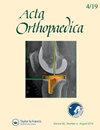Prognostic model development for risk of curve progression in adolescent idiopathic scoliosis: a prospective cohort study of 127 patients.
IF 2.5
2区 医学
Q1 ORTHOPEDICS
引用次数: 0
Abstract
BACKGROUND AND PURPOSE The study's purpose was to develop and internally validate a prognostic survival model exploring baseline variables for adolescent idiopathic scoliosis curve progression. METHODS A longitudinal prognostic cohort analysis was performed on trial data (n = 135) including girls and boys, Cobb angle 25-40°, aged 9-17 years, remaining growth > 1 year, and previously untreated. Prognostic outcome was defined as curve progression of Cobb angle of > 6° prior to skeletal maturity. 34 candidate prognostic variables were tested. Time-to-event was measured with 6-month intervals. Cox proportional hazards regression survival model (CoxPH) was used for model development and validation in comparison with machine learning models (66.6/33.3 train/test data set). The models were adjusted for treatment exposure. RESULTS The final primary prognostic model included 127 patients, predicting progress with acceptable discriminative ability (concordance = 0.79, 95% confidence interval [CI] 0.72-0.86). Significant prognostic risk factors were Risser stage of 0 (HR 4.6, CI 2.1-10.1, P < 0.001), larger major curve Cobb angle (HRstandardized 1.5, CI 1.1-2.0, P = 0.005), and higher score on patient-reported pictorial Spinal Appearance Questionnaire (pSAQ) (HRstandardized 1.4, CI 1.0-1.9, P = 0.04). Treatment exposure, entered as a covariate adjustment, contributed significantly to the final model (HR 3.1, CI 1.5-6.0, P = 0.001). Sensitivity analysis displayed that CoxPH maintained acceptable discriminative ability (AUC 0.79, CI 0.65-0.93) in comparison with machine learning algorithms. CONCLUSION The prognostic model (Risser stage, Cobb angle, pSAQ, and menarche) predicted curve progression of > 6° Cobb angle with acceptable discriminative ability. Adding patient report of the pSAQ may be of clinical importance for the prognosis of curve progression.青少年特发性脊柱侧弯症曲线恶化风险预后模型的开发:一项对 127 名患者进行的前瞻性队列研究。
研究方法对试验数据(n = 135)进行了纵向预后队列分析,试验对象包括女孩和男孩,Cobb 角为 25-40°,年龄为 9-17 岁,剩余生长时间大于 1 年,之前未接受过治疗。预后结果的定义是,在骨骼发育成熟之前,Cobb 角的曲线进展大于 6°。对 34 个候选预后变量进行了测试。事件发生时间以 6 个月为间隔。Cox比例危害回归生存模型(CoxPH)用于模型开发和验证,并与机器学习模型进行比较(66.6/33.3 训练/测试数据集)。结果最终的主要预后模型包括127名患者,以可接受的判别能力(一致性=0.79,95%置信区间[CI] 0.72-0.86)预测病情进展。重要的预后风险因素包括:Risser分期为0(HR 4.6,CI 2.1-10.1,P <0.001),主要曲线Cobb角较大(HR标准化为1.5,CI 1.1-2.0,P =0.005),以及患者报告的图形脊柱外观问卷(pSAQ)得分较高(HR标准化为1.4,CI 1.0-1.9,P =0.04)。作为协变量调整的治疗暴露对最终模型有显著影响(HR 3.1,CI 1.5-6.0,P = 0.001)。敏感性分析表明,与机器学习算法相比,CoxPH 保持了可接受的判别能力(AUC 0.79,CI 0.65-0.93)。结论预后模型(Risser 分期、Cobb 角、pSAQ 和月经初潮)可预测 Cobb 角大于 6° 的曲线进展,具有可接受的判别能力。增加患者报告的 pSAQ 可能对曲线进展的预后具有重要的临床意义。
本文章由计算机程序翻译,如有差异,请以英文原文为准。
求助全文
约1分钟内获得全文
求助全文
来源期刊

Acta Orthopaedica
医学-整形外科
CiteScore
6.40
自引率
8.10%
发文量
105
审稿时长
4-8 weeks
期刊介绍:
Acta Orthopaedica (previously Acta Orthopaedica Scandinavica) presents original articles of basic research interest, as well as clinical studies in the field of orthopedics and related sub disciplines. Ever since the journal was founded in 1930, by a group of Scandinavian orthopedic surgeons, the journal has been published for an international audience. Acta Orthopaedica is owned by the Nordic Orthopaedic Federation and is the official publication of this federation.
 求助内容:
求助内容: 应助结果提醒方式:
应助结果提醒方式:


